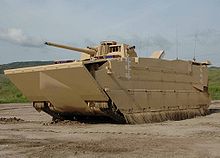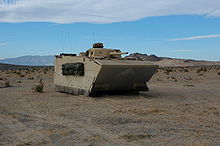Expeditionary Fighting Vehicle
The Expeditionary Fighting Vehicle , or EFV for short , was a planned amphibious vehicle for the United States Marine Corps (USMC) and was scheduled to go into service in 2015. Until the end of 2003, the name Advanced Amphibious Assault Vehicle (AAAV) was used. The program was discontinued in 2011.
The vehicle was an amphibious armored personnel carrier that was launched from sea from an amphibious assault ship and was supposed to drop a group of marines on the coast.
The EFV was designed to replace the aging AAV7 and should have been the USMC's most important acquisition in the field of ground-based weapons systems. The speed in the water, the armor and firepower should be significantly increased compared to the AAV.
development
In the 1980s, the USMC developed the so-called "over the horizon" strategy for amphibious landing operations. The intention was not to expose the transport ships needed for the amphibious forces to any danger from coastal defenses and sea mines . This strategy included the MV-22 Osprey , the LCAC, and the EFV.
Development of the AAAV began in the late 1970s, with the first prototypes being built in the early 1980s. The predecessor of the AAAV was the AAVP7. Its operating time was significantly increased by a general overhaul, resulting in the AAVP7A1. Originally the commissioning of the AAAV was planned for 1993. Due to delays in development, the AAVP7 was modernized again in the following period, while the USMC was still waiting for the completion of the vehicle, renamed EFV in 2003, whose development at that time was 18 years behind the original schedule.
The requirements for the vehicle stipulated that it should be able to cover a distance of 25 kilometers between the transport ship and the coast at high speed. The AAV can only swim two miles. The EFV should reach 20 knots (about 37 km / h) on the water and 45 km / h on the road. The tank range on land should be 345 miles (approximately 555 km). Originally, the USMC wanted to buy 1,025 vehicles for a total of $ 8.5 billion. The US military budget earmarked $ 256 million for the EFV project in 2009.
In early January 2011, the US Department of Defense announced that it would cancel the EFV project due to cost reasons. In return, the existing AAV7 vehicles are to be modernized and a cheaper alternative is to be purchased at a time that has not yet been determined.
design
The General Dynamics EFV was an amphibious armored tracked vehicle with an aluminum hull. The drive consisted of an adapted, highly charged series 883 diesel engine from MTU Friedrichshafen , which had two different operating modes for movement in water and on land. The electrical system was supplied by a spray oil-cooled 28V / 800A generator.
The hull had a hydraulically controlled bow flap to improve the behavior when gliding over the water. Encapsulated water jet drives were integrated on both sides of the hull, and hydraulically controlled flaps protected the chains during operation in the water. The aluminum fuselage sparked some controversy due to its possible lack of protective function and risk of ignition.
The crew consisted of three soldiers and up to 17 marines were to be transported with their equipment.
There was also the version EFV-C1, which was to serve as a command platform for a seven-person staff. This contained secure electronics for guiding the squad in place of 30-mm automatic cannon .
Equipment and armament
The EFV had composite armor, protection against mine explosions and a system to ward off atomic, biological or chemical contamination of the occupants. In the standard version, the EFV had a Bushmaster II 30 mm automatic cannon as its main armament .
Further equipment:
- 7.62 mm coaxial machine gun in the turret
- Smoke throwing system
- Tailgate for the exit of the transported infantrymen
- Skylights
- Reinforced crew cell
controversy
During the long development period, the EFV program has seen several revisions, deadline extensions and technical problems. Originally, the USMC intended to procure 1,025 vehicles, which was reduced to just 573 vehicles due to the cost increases in the course of development, before the program was finally discontinued entirely.
Reliability problems
In February 2007, the Washington Post reported that the USMC was dissatisfied with the reliability of the EFV in use and production would not start as planned. In test runs of four vehicles each, one should already have failed due to a technical failure after 30 minutes of use. The USMC requested seven new prototypes, most of which should have better buoyancy and an improved turret. These prototypes should be completed in early 2010.
Additional protection against improvised explosive devices
The subcommittee on sea power and expeditionary forces of the House, in June 2007, sent members a letter to the commander of the USMC, in which they called this to a better protection of the EFV prior improvised explosive devices ( IEDs , Eng. IED to care).
New battle environment
At the beginning of the development project, a safe distance of 25 miles for the transport ships seemed sufficient to make them largely invulnerable to coastal weapons. In view of today's anti-ship missiles, this is no longer the case.
literature
- Andrew Feickert: The Marine's Expeditionary Fighting Vehicle (EFV): Background and Issues for Congress. Congressional Research Service, December 19, 2008.
Web links
- Official USMC Site (English)
- MTU diesel engines for military vehicles (English)
- Globalsecurity EFV article (English)
Individual evidence
- ↑ FFA in Defense News . Retrieved December 27, 2010.
- ↑ http://www.defenseindustrydaily.com/the-usmcs-expeditionary-fighting-vehicle-sdd-phase-updated-02302/#more-2302
- ↑ MTU page


